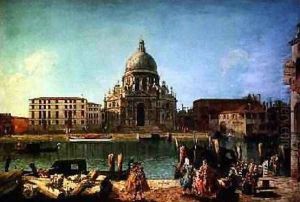M. & Guardi, G.A Marieschi Paintings
Michele Marieschi, born in 1710 in Venice, Italy, and Giovanni Antonio Guardi, born in 1699 in Vienna, Austria, are two distinct artists from the 18th century, often celebrated for their contributions to the Venetian school of painting. While they were contemporaries, their lives and artistic careers followed different paths, reflecting the vibrancy and diversity of 18th-century Venetian art.
Michele Marieschi is best known for his vedute, or detailed paintings of Venice, capturing the grandeur and architectural beauty of the city with a remarkable attention to detail. His work is often compared to that of Canaletto and Guardi, with whom he shares a penchant for depicting Venice's picturesque canals, bridges, and palazzos. Marieschi's career took off after his return to Venice from Germany in the early 1730s, where he initially worked more as an engraver and scene painter. His most productive period was in the 1730s and 1740s, during which he created the majority of his known works, including the famous series of prints 'Magnificentiores Selectioresque Urbis Venetiarum Prospectus' (1741-1742), which contributed significantly to his fame. Marieschi's style is characterized by dynamic compositions and a masterful use of light, which brings his views of Venice to life. Unfortunately, his career was cut short by his early death in 1743.
Giovanni Antonio Guardi, on the other hand, is often mentioned in the context of his more famous younger brother, Francesco Guardi, one of the last great masters of Venetian veduta painting. Giovanni Antonio's work, however, merits attention for its contribution to the Rococo movement and the development of 18th-century Venetian art. His paintings often feature religious and genre scenes, characterized by their lightness, delicate colors, and fluid brushwork. Although less is known about Giovanni Antonio's life compared to his brother, it is clear that he was an integral part of the Guardi family's artistic legacy, contributing to the rich tapestry of Venetian painting. His death in 1760 marked the end of a career that, while overshadowed by his brother's success, played a critical role in the evolution of Venetian art.
Together, Michele Marieschi and Giovanni Antonio Guardi embody the diversity and dynamism of Venetian painting in the 18th century. Their works, though differing in subject matter and style, each capture the spirit of their time, offering invaluable insights into the artistic and cultural life of Venice.
